| Article ID | Journal | Published Year | Pages | File Type |
|---|---|---|---|---|
| 2414006 | Agriculture, Ecosystems & Environment | 2014 | 7 Pages |
•Inorganic vs. combined organic and inorganic fertilizers have been tested for tomato.•Compost addition improves the efficiency of the inorganic fertilizers.•Microbial soil characteristics are improved with the use of combined fertilization.•Mineral N can be reduced with combined fertilization while obtaining similar yields.•Combined fertilization allows reducing 40% mineral N consumption.
The feasibility of using combined organic and inorganic fertilizers as an alternative to conventional inorganic fertilization was tested for tomato crops. To do this, two different composts (compost from a mixture of cow manure + alperujo + olive prunings and compost from sheep and goat manure) were added to an agricultural soil either, alone or along with inorganic fertilization, for tomato cultivation in greenhouse conditions. Conventional inorganic fertilization was used as reference. When used alone, the organic fertilizers led to lower N concentrations in leaves and fruits than the conventional inorganic fertilization. The combined use of compost and inorganic fertilizer, however, produced higher yields and better fruit quality than soils that underwent the respective inorganic treatment when used alone. In addition, soils with combined fertilization showed higher values of microbial biomass C, basal respiration and dehydrogenase activity than the respective inorganic treatment. The conjunctive use of compost and inorganic fertilizer made it possible to reduce inorganic fertilization by about 40% while obtaining similar fruit quality and amounts in addition to improving soil characteristics.
